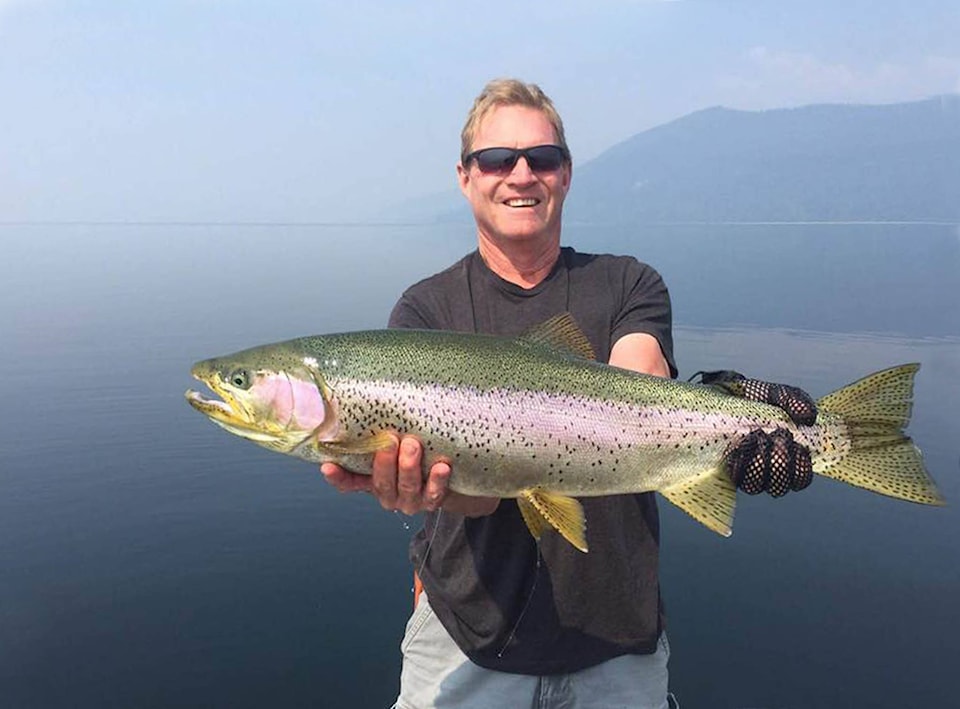*Editor’s Note: This feature is one of many published in the Williams Lake Tribune’s Gateway to Fishing and Adventure, out soon. The publication gives information on lakes north of Quesnel, west to Bella Coola, east to Quesnel Lake and south of 100 Mile House and all areas in between.
Biologists examining the effects of angling pressures on resident rainbow, bull and lake trout in Quesnel Lake have been given the green light to carry on their critical work.
The Quesnel Lake fish tagging program, which was launched in 2013 in response to public reports of improved fish numbers in the lake and requests to review the restrictive fishing regulations, is entering its six year and relies on a combination of a high tech fish-tracking system and reporting from anglers.
Lee Williston, study leader and senior fisheries biologist with the Ministry of Forests, Lands and Natural Resource Operations, said he is very pleased the Habitat Conservation Trust Foundation has approved funding for the continuation of the Quesnel Lake tag-telemetry study.
“The knowledge we have gained over the last several years has really exceeded all our expectations,” Williston said. “The number one priority is to ensure the long term sustainability of Quesnel Lake trout populations. But we also don’t want to be unnecessarily restrictive. We want people out there fishing and enjoying the resource and the better information we have, the less precautionary we need to be.”
The study has netted a prestigious provincial award, accolades from professionals in the field and critical information to ensure the long-term survival of the species, shedding light on critical questions surrounding the different species, such as the species’ mortality rates, use of habitat and sensitivity to angling pressures.
Read more: Ice fishing a part of winter in the Cariboo
Read more: Outdoor adventure awaits at Biff’s Pond
Since 2013, a total of 520 trout have had acoustic tags implanted and 33 acoustic receivers have been set throughout the watershed. When an acoustic-tagged fish travels within approximately 700 metres of a receiver, the unique identification number, date, time, location and depth of the fish is recorded. Each acoustic tagged fish also has floy tags inserted near the dorsal fin. When anglers capture a fish with these tags, they are asked to clip off the tags and call the tag numbers into the MFLNRORD office in Williams Lake (the phone number is on the tags). A $100 reward is sent to the angler for reporting the capture of a tagged fish.
A total of 97 reward-tagged trout have been recaptured and reported from 2013-2017. Funding for rewards has been provided by the Freshwater Fisheries Society of BC.
“Results to date have shown that the lake trout population is very robust and the percentage of the population captured by anglers is low. Thus the daily quota for lake trout has been increased from one per day to five per day.”
Conversely, rainbow trout exploitation has been significantly higher and variable.
“Therefore, no changes to the current daily quota are being proposed at this time,” he said.
The genetically-unique Horsefly strain of rainbow trout in Quesnel Lake is highly sought-after in the sport fishery due to its large size and aggressive behaviour. Those attributes that make them so attractive to anglers, however, also makes them vulnerable to over-fishing, he noted.
“They are a large-bodied predator cruising around looking for prey. They need a high-energy food source and they’re very aggressive. This aggressiveness makes them highly catchable which can make it appear as though there are far more fish than there really are.”
The study is also providing some information on the lesser known, more elusive bull trout.
“Bull trout are a tough one to put in a box,” he said. “We are learning that there are multiple distinct populations of bull trout that use the Quesnel Lake system.”
Williston said the bull trout, which are strictly a catch and release fishery on Quesnel Lake, are a sensitive, cold water fish that require steep, cool streams to live in for the first one to three years of its life. The limited availability of suitable rearing habitat naturally limits their numbers. He said Quesnel Lake is one of the few lakes in the Province that support both bull trout and lake trout populations. The availability of salmon within the watershed seems to have allowed bull trout to carve out a niche within the system.
Moving forward, Williston said the MFLNRORD will continue to evaluate exploitation rates and survival of Quesnel Lake trout. However, there will also be a significant focus on using acoustic telemetry to identify critical habitats such as spawning and rearing areas for protection and/or future enhancement to ensure long-term sustainability of trout stocks in Quesnel Lake.
“The success of this project has been largely due to the excellent response and participation from the angling public. The MFLNRORD would like to thank everyone who has reported the capture of tagged fish and encourages anglers to continue to report captures moving forward. If anglers have any questions or would like additional information regarding the Quesnel Lake tag reward program please contact the MFLNRORD office in Williams Lake(250-398-4574).”
